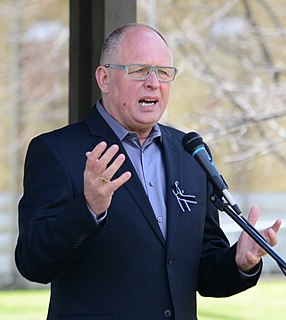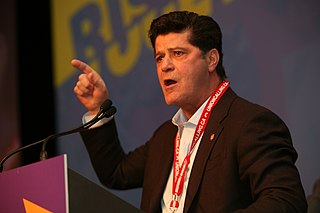
The Canadian Auto Workers was one of Canada's largest and highest profile labour unions. In 2013, it merged with the Communications, Energy and Paperworkers Union of Canada, forming a new union, Unifor. While rooted in Ontario's large auto plants of Windsor, Brampton, Oakville, St. Catharines, and Oshawa, the CAW has expanded and now incorporates workers in almost every sector of the economy. The presidents of the CAW were Bob White (1985-1992), Buzz Hargrove (1992-2008), Ken Lewenza (2008-2013), and Jerry Dias (2013–present) when the CAW became UNIFOR.

The Canadian Labour Congress, or CLC is a national trade union centre, the central labour body in Canada to which most Canadian labour unions are affiliated.

The Public Service Alliance of Canada (PSAC) is one of Canada's largest national labour unions and the largest union in the Canadian federal public sector. PSAC members work in every province and territory, and also work abroad in embassies and consulates.
The Canadian Union of Public Employees is a Canadian trade union serving the public sector – although it has in recent years organized workplaces in the non-profit and para-public sector as well. CUPE is the largest union in Canada, representing some 700,000 workers in health care, education, municipalities, libraries, universities, social services, public utilities, transportation, emergency services and airlines. Over 60% of CUPE's members are women, and almost a third are part-time workers. CUPE is affiliated with the Canadian Labour Congress and is its greatest financial contributor.

Patrick Cyril "Sid" Ryan is a Canadian labour union leader and politician. Ryan is the former president of the Ontario Federation of Labour.

The International Union of Operating Engineers (IUOE) is a trade union within the United States-based AFL-CIO representing primarily construction workers who work as heavy equipment operators, mechanics, surveyors, and stationary engineers who maintain heating and other systems in buildings and industrial complexes, in the United States and Canada.

The Canadian Media Guild (CMG) is a trade union representing employees at the Canadian Broadcasting Corporation, the Canadian Press, Thomson Reuters, Agence France-Presse, the Aboriginal Peoples Television Network, Corus Entertainment, CJRC Radio in Gatineau, Que., TVOntario and ZoomerMedia.
The Canadian Union of Public Employees, Local 3902 is a Canadian labour union local representing sessional lecturers, postdoctoral researchers and teaching assistants (TAs) at the University of Toronto, Victoria University in the University of Toronto, the University of St. Michael's College and New College in the University of Toronto.
This is a timeline of labour issues and events in Canada.
Most Toronto Transit Commission personnel are members of the Amalgamated Transit Union Local 113. Total membership (2016) is approximately 10000 members. The ATU has represented Toronto Transit Commission (TTC) workers since 1899; workers of predecessor operators have been represented by the ATU's predecessor, the Amalgamated Association of Street Railway Employees of America. The president of ATU Local 113 was Bob Kinnear, who held the post from 2003 until February 3, 2017, and now under the leadership of Carlos Santos as of January 2019.

The 2009 City of Toronto inside and outside workers strike was a legal strike action that was undertaken by the Toronto Civic Employees Union Local 416 and CUPE Local 79, two locals of the Canadian Union of Public Employees in the city of Toronto.
The Construction Maintenance and Allied Workers Canada (CMAW) is a construction trade union headquartered in Vancouver. CMAW negotiates pay and work conditions on behalf of its 4,000 members in British Columbia and Alberta. Union members include carpenters, shipbuilders, scaffolders, pipefitters, millwrights, lathers, cabinetmakers, display technicians, industrial workers and school board employees.
Stanley Little was the founding National President of the Canadian Union of Public Employees from 1963 to 1975. He was also the President of the National Union of Public Service Employees from 1961 to 1963.

Unifor is a general trade union in Canada and the largest private sector union in Canada. It was founded in 2013 as a merger of the Canadian Auto Workers (CAW) and Communications, Energy and Paperworkers unions, and consists of 310,000 workers and associate members in industries ranging from manufacturing and media to aviation, forestry and fishing. In January 2018, the union left the Canadian Labour Congress, Canada's national trade union centre, to become independent.

Jerome P. Dias Jr. is a Canadian trade unionist who was elected the first national president of Unifor in August 2013 at the union’s founding convention following the merger between the Canadian Auto Workers and the Communications, Energy and Paperworkers Union of Canada.
The following is a timeline of the history of labour organizations in communities in and around Greater Sudbury, Ontario, Canada. Listings for incorporated townships which were later amalgamated with the City of Sudbury are noted separately.

The 2018 York University strike was a strike by CUPE Local 3903, the union representing contract professors, teaching assistants, and graduate assistants at York University. At 143 days long it is the longest strike in the post-secondary sector in Canadian history, surpassing the previous record of the 1976 Laval University 108-day strike. It ended on July 25, when the Ontario Legislature passed the Urgent Priorities Act back-to-work legislation.
The 2020 Port of Montreal strike began at 7:00 AM on August 10, 2020 after Local 375 of the Canadian Union of Public Employees walked off the jobsite. The local had previously voted for an indefinite strike. The strike is part of a dispute dating back to 2018, when the union and management were unable to negotiate a new contract. The strike was primarily about shift work and work-life balance for the longshore and maintenance workers who are required to work 19 days in a row before having two off.

The Toronto Typographical Union (TTU) was an early Canadian trade union in the printing industry. Founded in 1832, it came to prominence in 1872 when it organized a major strike in Toronto. Membership declined in the mid- to late-20th century as printing turned digital. By 1994, TTU had been absorbed by the Communications, Energy and Paperworkers Union of Canada.
The 2021 New Brunswick public sector strike was labour strike in the Canadian province of New Brunswick involving employees of the provincial government, represented by the Canadian Union of Public Employees (CUPE). In October 2021, the workers voted to take strike action.











